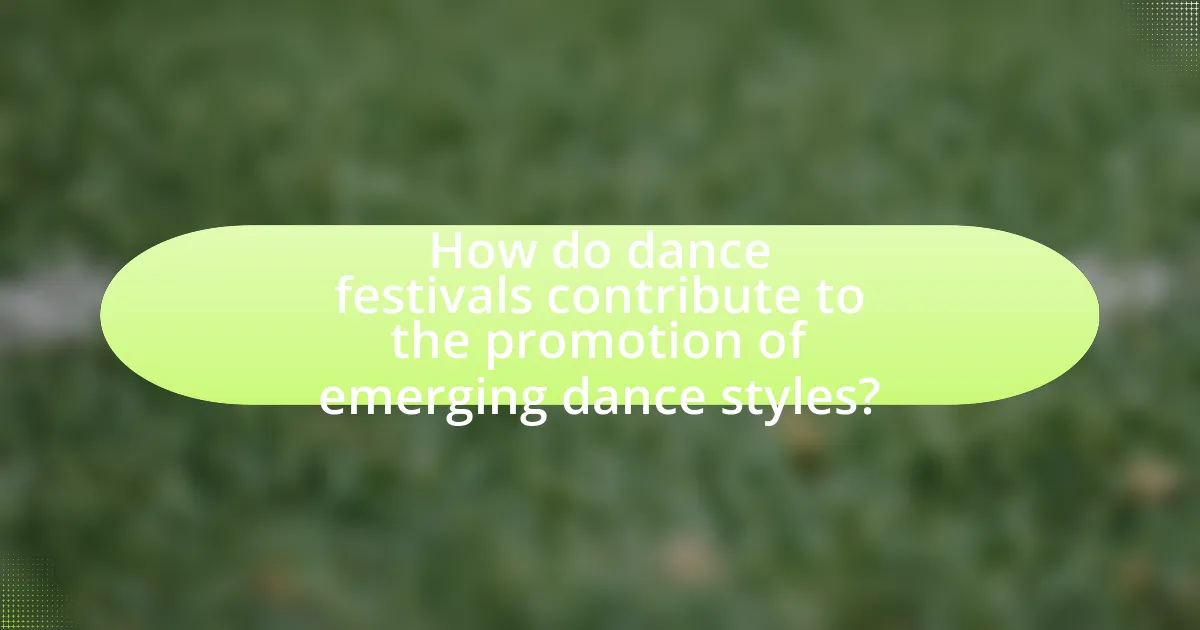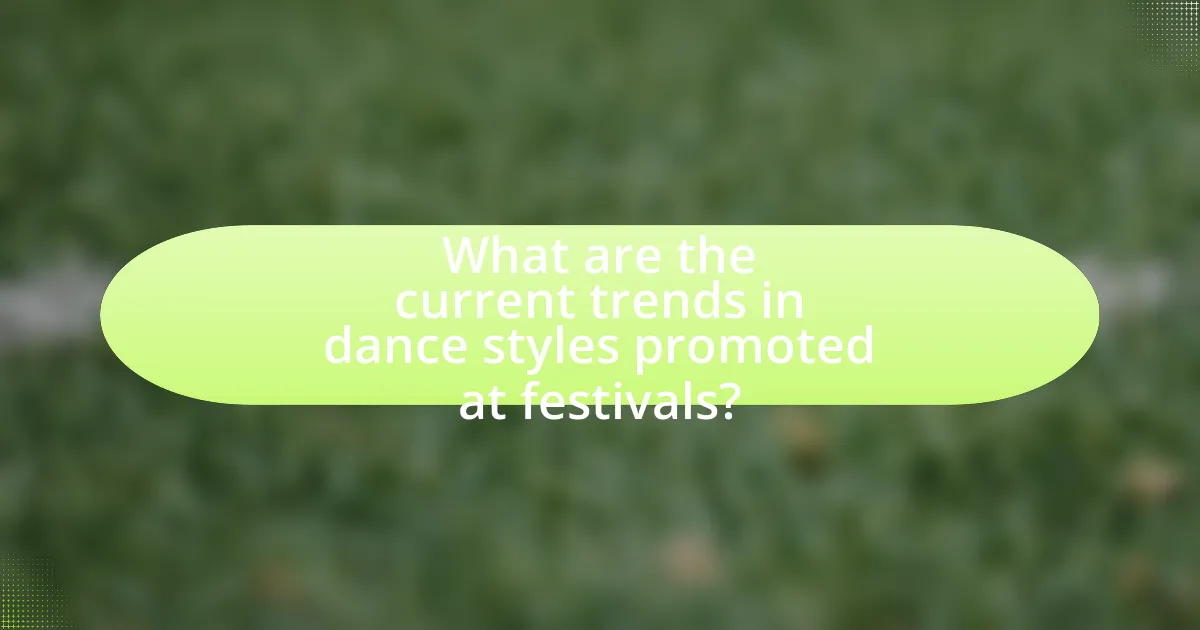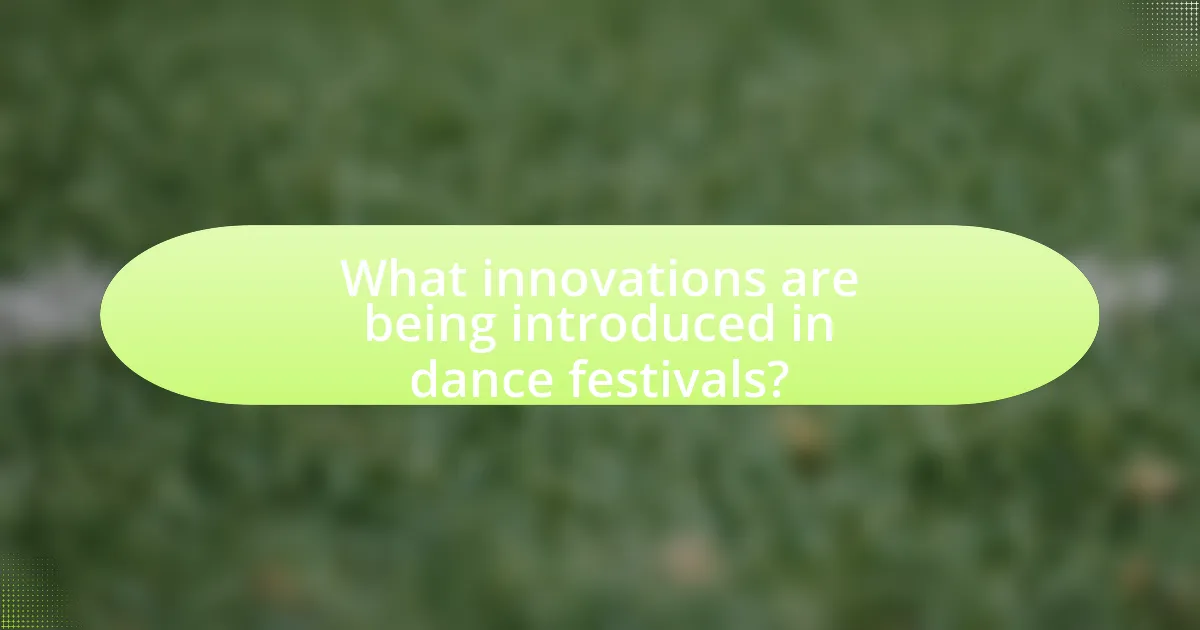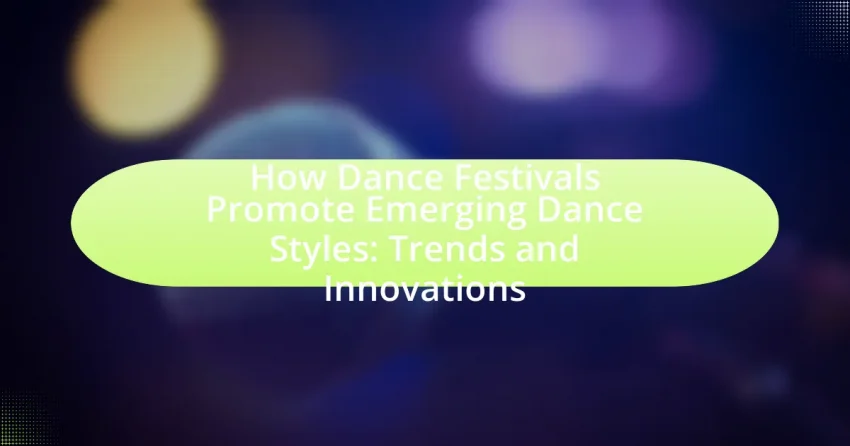Dance festivals serve as vital platforms for promoting emerging dance styles, facilitating exposure, collaboration, and innovation among artists. Events such as the Edinburgh Festival Fringe and the American Dance Festival showcase diverse performances and contemporary choreography, influencing trends within the dance community. These festivals not only highlight new styles but also foster cultural exchange and audience engagement through workshops and interactive experiences. Additionally, the integration of technology and social media has transformed how dance is shared and experienced, further enhancing the visibility of emerging artists and their work. The article explores the impact of dance festivals on the evolution of dance styles, current trends, and the challenges faced by new artists in this dynamic environment.

How do dance festivals contribute to the promotion of emerging dance styles?
Dance festivals significantly contribute to the promotion of emerging dance styles by providing a platform for exposure and collaboration among artists. These events showcase innovative choreography and diverse performances, allowing new styles to reach wider audiences. For instance, festivals like the Edinburgh Festival Fringe and the American Dance Festival have featured contemporary and experimental dance, which has led to increased recognition and acceptance of these styles within the mainstream dance community. Additionally, workshops and networking opportunities at these festivals facilitate connections between emerging artists and established professionals, fostering mentorship and collaboration that further enhances the visibility and development of new dance forms.
What role do dance festivals play in showcasing new trends?
Dance festivals play a crucial role in showcasing new trends by providing a platform for emerging choreographers and dancers to present innovative works. These festivals often feature a diverse range of styles, allowing artists to experiment and push boundaries, which in turn influences the broader dance community. For instance, events like the Edinburgh Festival Fringe and the Jacob’s Pillow Dance Festival have historically introduced audiences to groundbreaking performances that later become influential in the dance world. By highlighting these new trends, dance festivals not only celebrate creativity but also help shape the future of dance by fostering collaboration and dialogue among artists and audiences.
How do festivals create platforms for innovative choreography?
Festivals create platforms for innovative choreography by providing a space for diverse artists to showcase their work, collaborate, and experiment with new ideas. These events often feature a variety of performances, workshops, and discussions that encourage creativity and the exchange of techniques among choreographers. For instance, festivals like the Edinburgh Festival Fringe and Jacob’s Pillow Dance Festival have historically supported emerging choreographers by offering them visibility and access to audiences, which can lead to further opportunities in the dance community. This environment fosters innovation as artists are inspired by each other’s work and the feedback they receive, ultimately pushing the boundaries of traditional choreography.
What opportunities do festivals provide for emerging artists?
Festivals provide emerging artists with vital exposure, networking opportunities, and platforms to showcase their work. By participating in festivals, these artists can reach diverse audiences, which can lead to increased visibility and potential collaborations. For instance, festivals often attract industry professionals, including agents and producers, who scout for new talent, thereby enhancing the artists’ chances of career advancement. Additionally, many festivals offer workshops and mentorship programs, allowing emerging artists to refine their skills and gain insights from established professionals in the field. This combination of exposure, networking, and skill development makes festivals a crucial stepping stone for emerging artists in the dance industry.
Why are dance festivals important for cultural exchange?
Dance festivals are important for cultural exchange because they serve as platforms for diverse artistic expressions and foster intercultural dialogue. These events bring together dancers and audiences from various backgrounds, allowing them to share their unique traditions, techniques, and styles. For instance, the International Dance Festival in Paris showcases performances from over 30 countries, highlighting the global nature of dance and promoting understanding among different cultures. This interaction not only enriches the participants’ artistic perspectives but also cultivates appreciation for cultural diversity, ultimately enhancing social cohesion and mutual respect among communities.
How do festivals facilitate the sharing of diverse dance styles?
Festivals facilitate the sharing of diverse dance styles by providing a platform for artists from various cultural backgrounds to showcase their work. These events often feature performances, workshops, and competitions that encourage interaction among dancers and audiences, promoting cross-cultural exchange. For instance, the Edinburgh Festival Fringe, one of the largest arts festivals in the world, includes a wide array of dance performances that highlight different styles, from traditional folk dances to contemporary choreography. This exposure allows participants to learn from one another, fostering innovation and the blending of styles. Additionally, festivals often attract international participants, further enriching the diversity of dance styles presented and experienced by attendees.
What impact does cultural exchange have on dance innovation?
Cultural exchange significantly enhances dance innovation by introducing diverse techniques, styles, and perspectives. This interaction fosters creativity as dancers and choreographers blend elements from various cultures, leading to the emergence of new forms and expressions. For instance, the integration of African dance rhythms into contemporary ballet has resulted in innovative choreography that challenges traditional boundaries. Historical examples include the Harlem Renaissance, where African American cultural influences transformed American dance, creating new genres like jazz dance. Such exchanges not only enrich the artistic landscape but also promote cross-cultural understanding and collaboration, further driving innovation in dance.

What are the current trends in dance styles promoted at festivals?
Current trends in dance styles promoted at festivals include a significant rise in electronic dance music (EDM) styles, hip-hop, and fusion genres that blend traditional and contemporary movements. Festivals increasingly showcase diverse dance forms, reflecting cultural influences and the popularity of social media platforms that highlight viral dance challenges. For instance, the integration of styles like K-pop and Afrobeat has gained traction, as evidenced by the growing number of festivals featuring these genres, such as Coachella and Tomorrowland, which attract large audiences and promote innovative choreography. Additionally, immersive experiences that combine dance with technology, such as augmented reality and interactive performances, are becoming prevalent, enhancing audience engagement and participation.
How have social media and technology influenced dance trends at festivals?
Social media and technology have significantly influenced dance trends at festivals by facilitating the rapid dissemination of new styles and choreography. Platforms like Instagram and TikTok allow dancers and choreographers to share their performances instantly, reaching a global audience and inspiring others to adopt these trends. For example, viral dance challenges often emerge from festival performances, leading to widespread participation and adaptation across various demographics. Additionally, technology such as live streaming enables festivals to showcase diverse dance styles to viewers who cannot attend in person, further promoting these trends. The integration of social media and technology has thus created a dynamic environment where dance styles can evolve quickly and gain popularity on a large scale.
What role does online promotion play in festival attendance?
Online promotion significantly enhances festival attendance by increasing visibility and engagement among potential attendees. Festivals that utilize social media platforms, targeted advertising, and email marketing can reach broader audiences, leading to higher ticket sales. For instance, a study by Eventbrite found that 80% of event attendees discover events through social media, highlighting the effectiveness of online channels in driving attendance. Additionally, online promotion allows for real-time updates and interactions, fostering a sense of community and excitement that can further motivate individuals to attend.
How do digital platforms shape audience engagement with dance?
Digital platforms significantly enhance audience engagement with dance by providing accessible content, interactive experiences, and community-building opportunities. These platforms, such as social media and streaming services, allow audiences to view performances, tutorials, and behind-the-scenes content from anywhere in the world, thus broadening the reach of dance beyond traditional venues. For instance, a study by the Pew Research Center indicates that 69% of adults in the U.S. use social media, which facilitates sharing and discussion about dance, fostering a sense of community among fans and dancers alike. Additionally, platforms like Instagram and TikTok enable users to create and share their own dance videos, encouraging participation and creativity, which further deepens engagement.
What emerging dance styles are gaining popularity at festivals?
Emerging dance styles gaining popularity at festivals include shuffle dance, waacking, and krumping. Shuffle dance, characterized by quick footwork and sliding movements, has seen a rise in festival settings, particularly within electronic dance music scenes. Waacking, which emphasizes arm movements and poses, has gained traction due to its expressive nature and connection to LGBTQ+ culture. Krumping, known for its energetic and aggressive style, has also become more visible at festivals, often showcased in battles and performances. These styles reflect the evolving landscape of dance influenced by social media and cultural exchange, making them increasingly prominent in festival lineups.
Which styles are being highlighted in recent festival lineups?
Recent festival lineups are highlighting styles such as electronic dance music (EDM), hip-hop, and contemporary dance. These genres have gained prominence due to their widespread appeal and the integration of innovative choreography and technology. For instance, major festivals like Coachella and Tomorrowland have featured a mix of EDM and hip-hop artists, showcasing the fusion of these styles and attracting diverse audiences. Additionally, contemporary dance performances at festivals emphasize experimental movements and collaborations with visual artists, reflecting current trends in the dance community.
How do these styles reflect contemporary societal themes?
Emerging dance styles showcased at festivals reflect contemporary societal themes by addressing issues such as identity, diversity, and social justice. For instance, styles like hip-hop and contemporary dance often incorporate elements that highlight cultural narratives and personal experiences, resonating with audiences who seek representation and inclusivity. Research indicates that dance serves as a medium for social commentary, with festivals providing a platform for artists to express and challenge societal norms, thereby fostering dialogue around pressing issues like race, gender, and community. This connection between dance and societal themes is evident in the increasing popularity of performances that engage with activism, as seen in events like the Dance/NYC Symposium, which emphasizes the role of dance in advocating for equity and access within the arts.

What innovations are being introduced in dance festivals?
Dance festivals are introducing innovations such as immersive technology, interactive performances, and diverse programming to enhance audience engagement and showcase emerging dance styles. For instance, the integration of virtual reality and augmented reality allows attendees to experience performances in new dimensions, creating a more engaging atmosphere. Additionally, festivals are increasingly featuring cross-genre collaborations, which promote the fusion of traditional and contemporary dance forms, reflecting the evolving landscape of dance. These innovations not only attract a broader audience but also provide a platform for emerging artists to present their work in a dynamic environment.
How are festivals adapting to new audience expectations?
Festivals are adapting to new audience expectations by incorporating diverse programming, enhancing digital engagement, and prioritizing sustainability. For instance, many festivals now feature a wider range of dance styles, including emerging genres, to attract varied demographics and reflect cultural shifts. Additionally, the integration of virtual components allows audiences to participate remotely, catering to those who prefer digital experiences or cannot attend in person. According to a 2022 survey by Eventbrite, 70% of festival-goers expressed a desire for hybrid events that combine in-person and online elements. Furthermore, festivals are increasingly focusing on eco-friendly practices, responding to audience concerns about environmental impact, with 60% of attendees indicating that sustainability influences their event choices.
What interactive experiences are being offered to festival-goers?
Dance festivals are offering interactive experiences such as dance workshops, live performances, and immersive installations. These activities allow festival-goers to engage directly with emerging dance styles and techniques, fostering a deeper understanding and appreciation of the art form. For instance, workshops led by renowned choreographers provide hands-on learning opportunities, while live performances showcase innovative dance interpretations, enhancing the overall festival experience.
How do festivals incorporate technology into performances?
Festivals incorporate technology into performances by utilizing advanced audiovisual systems, interactive installations, and digital platforms to enhance audience engagement and artistic expression. For instance, many festivals employ projection mapping to create immersive environments that transform traditional stages into dynamic visual experiences. Additionally, live streaming technology allows performances to reach global audiences, expanding the festival’s impact beyond physical attendees. According to a report by the International Federation of Arts Councils and Culture Agencies, 70% of festivals have integrated some form of digital technology to innovate their programming and attract younger audiences. This integration not only modernizes the performance experience but also fosters collaboration between artists and technologists, leading to the emergence of new dance styles and forms.
What are the challenges faced by emerging dance styles at festivals?
Emerging dance styles at festivals face several challenges, including limited visibility, audience acceptance, and resource allocation. Limited visibility occurs because established dance forms often dominate festival lineups, making it difficult for new styles to gain exposure. Audience acceptance is another challenge, as festival-goers may be unfamiliar with or resistant to innovative forms, impacting their willingness to engage. Additionally, resource allocation can be problematic, as emerging styles may struggle to secure funding, rehearsal space, and professional support compared to more recognized genres. These challenges hinder the growth and recognition of new dance forms within the festival circuit.
How do funding and sponsorship affect the promotion of new styles?
Funding and sponsorship significantly enhance the promotion of new dance styles by providing financial resources that facilitate marketing, production, and outreach efforts. For instance, festivals that receive sponsorship can allocate funds towards high-quality production values, attracting larger audiences and media attention, which in turn elevates the visibility of emerging styles. Additionally, financial backing allows for collaborations with established artists and choreographers, creating platforms where new styles can be showcased effectively. Research indicates that events with substantial sponsorship often report increased attendance and engagement, demonstrating a direct correlation between funding and the successful promotion of innovative dance forms.
What barriers do emerging artists encounter in festival settings?
Emerging artists encounter several barriers in festival settings, including limited access to performance opportunities, financial constraints, and lack of industry connections. These barriers hinder their ability to showcase their work and gain visibility. For instance, many festivals prioritize established artists, making it difficult for newcomers to secure slots. Additionally, the costs associated with participation, such as travel and accommodation, can be prohibitive for emerging artists who often operate on tight budgets. Furthermore, without established networks, these artists may struggle to connect with key industry players, which is crucial for career advancement in the competitive festival environment.
What best practices can be adopted for promoting emerging dance styles at festivals?
To promote emerging dance styles at festivals, organizers should implement targeted marketing strategies, engage with local dance communities, and provide platforms for performance and education. Targeted marketing strategies, such as social media campaigns and collaborations with influencers in the dance community, can effectively reach audiences interested in new styles. Engaging with local dance communities fosters grassroots support and encourages participation, while providing platforms for performance allows emerging artists to showcase their work, thereby increasing visibility. Educational workshops and masterclasses can also enhance audience understanding and appreciation of these styles, leading to greater interest and attendance. These practices have been shown to successfully elevate the profile of emerging dance styles, as evidenced by festivals that have seen increased attendance and engagement through similar initiatives.
How can festival organizers effectively support new artists?
Festival organizers can effectively support new artists by providing platforms for exposure, such as dedicated stages or showcases specifically for emerging talent. This approach allows new artists to perform in front of diverse audiences, increasing their visibility and potential fan base. Additionally, organizers can offer mentorship programs that connect new artists with established professionals in the industry, facilitating skill development and networking opportunities. Research indicates that festivals that prioritize emerging artists often see increased audience engagement, as attendees appreciate discovering fresh talent. For example, the Edinburgh Festival Fringe has successfully implemented such initiatives, leading to a significant rise in the number of new artists gaining recognition.
What strategies can be implemented to enhance audience engagement with emerging styles?
To enhance audience engagement with emerging dance styles, festivals can implement interactive workshops that allow attendees to participate in the dance forms being showcased. Research indicates that hands-on experiences significantly increase audience connection and retention, as seen in the 2022 Dance Festival Survey, which reported a 40% increase in audience satisfaction when workshops were included. Additionally, utilizing social media platforms for live streaming performances and behind-the-scenes content can broaden reach and foster community interaction, as evidenced by the success of the 2023 Global Dance Festival, which saw a 50% increase in online engagement through these strategies.
